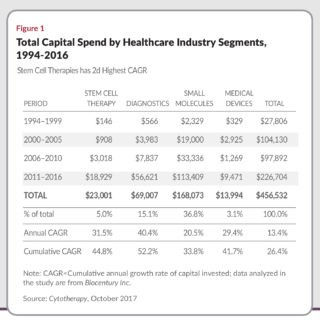ARTICLE SUMMARY:
The stem cell therapies market is booming, thanks to ongoing unmet clinical needs, demographics, marketing, and advances in technology, but medical professionals are grappling with lack of evidence for most applications. Senior writer Wendy Diller explored stem cells’ use in orthopedics in the June 27 issue of MedTech Strategist, and noted the exponential growth of financing for companies in the field.
Biologics are increasingly used in orthopedics to improve bone and soft tissue healing, as well as fusion rates, particularly as technological advances and marketing hype, put them front and center of solutions to some of orthopedics’ most intractable problems.
Businesses hyping biological treatments and in particular cell therapies that they call stem cells are proliferating, sometimes with minimal FDA oversight, raising ethical and regulatory issues. With few exceptions, however, evidence for most current applications remains weak, and much of the cost is borne by patients who pay out of pocket.
To illustrate just how much support has grown even in just the past two to three years for stem-cell therapies, one only has to look at financing trends (see Figure 1). Compared with medical devices, diagnostics, and other similar sub-sectors of healthcare, stem-cell therapy companies have raised money at a faster rate. Moreover, the amounts of raises have been growing exponentially; between 2011 to 2016, these companies raised $18.9 billion, or 130 times the amounts raised between 1994 and 1999 ($146 million), and 21 times the $908 million raised between 2000 to 2005, according to a stem cell industry update published in October 2017 by Ng et al. in Cytotherapy, which is the official Journal of the International Society for Cellular Therapy.
That pace continues to accelerate: between July 2017 and May 2018, cell and gene therapy companies like Celularity Inc, Vericel Corp., and AveXis Inc. each raised hundreds of millions of dollars in capital; in May, Novartis AG acquired AveXis, which is still in clinical development for its first product, for nearly $9 billion. While the latter two are not technically stem cell companies, and all three have programs for developing solid clinical evidence, both investors and patients do not always discriminate the nuances.
Read the full article in the June 27, 2018 Issue of MedTech Strategist: "Orthopedics Grapples with Evidence-Based Use of Stem Cell Therapies”
#MedicalDevice #CommunityBlog #strategy #medtech #medicaldevices #ICYMI #trends #stemcells #perspective #MedTechStrategist #global #wendydiller
![]() Trial MyStrategist.com and unlock 7-days of exclusive subscriber-only access to the medical device industry's most trusted strategic publications: MedTech Strategist & Market Pathways. For more information on our demographics and current readership click here.
Trial MyStrategist.com and unlock 7-days of exclusive subscriber-only access to the medical device industry's most trusted strategic publications: MedTech Strategist & Market Pathways. For more information on our demographics and current readership click here.
